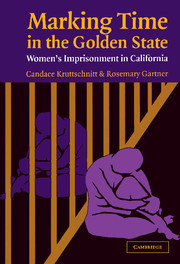Book contents
- Frontmatter
- Contents
- List of Figures and Tables
- Acknowledgments
- Marking Time in the Golden State
- 1 Introduction
- 2 Women, Crime, and Punishment in California
- 3 Entering the Prisons: Methods
- 4 Women's Experiences of Imprisonment at the California Institution for Women in the 1960s and the 1990s
- 5 Variations across Time and Place in Women's Prison Experiences
- 6 Negotiating Prison Life: How Women “Did Time” in the Punitive Era of the 1990s
- 7 Conclusion: The Spectrum of Women Prisoners' Experiences
- Appendix: Characteristics of Interviewees
- References
- Author Index
- Subject Index
4 - Women's Experiences of Imprisonment at the California Institution for Women in the 1960s and the 1990s
Published online by Cambridge University Press: 15 December 2009
- Frontmatter
- Contents
- List of Figures and Tables
- Acknowledgments
- Marking Time in the Golden State
- 1 Introduction
- 2 Women, Crime, and Punishment in California
- 3 Entering the Prisons: Methods
- 4 Women's Experiences of Imprisonment at the California Institution for Women in the 1960s and the 1990s
- 5 Variations across Time and Place in Women's Prison Experiences
- 6 Negotiating Prison Life: How Women “Did Time” in the Punitive Era of the 1990s
- 7 Conclusion: The Spectrum of Women Prisoners' Experiences
- Appendix: Characteristics of Interviewees
- References
- Author Index
- Subject Index
Summary
the august/september 1964 issue of the clarion, the prisoners' newsletter published through the California Institution for Women's (CIW) educational department “as a medium of self-expression and communication,” reprinted a local newspaper story entitled “Mrs. Dianne Feinstein: Housewife with a Cause” (Bushman, 1964). It is worth quoting from the story at some length for the sense it provides of penal practice and philosophy at CIW as well as notions about women's roles in the early 1960s.
“A bright young housewife from San Francisco who looks more like a fashion model has a 120-days a year job which probably would stump the experts on “What's My Line.” She's the youngest, certainly the prettiest, and one of the busiest women's parole board members in the United States. Mrs. Dianne Feinstein serves as vice-chairman of the parole board of the California Institution for Women – the largest women's prison in the U.S., located near Corona. This tall, slender brunette, one of three women on the five-member board, is now in her third year on the board “and doing an excellent job,” according to its chairman, Mrs. Elizabeth Lewis of Los Angeles. “Behind the delightfully feminine facade there is plenty of thinking going on,” points out Mrs. Lewis, a two-term board veteran who is especially proud of her protege.
Serving as a team they have led the present board through the most spectacular phase in CIW history: In-prison sentence time has been drastically cut in favor of longer and better supervised parole periods, and so far has proved beneficial not only to the prisoner but to the taxpayer and society in general. […]
- Type
- Chapter
- Information
- Marking Time in the Golden StateWomen's Imprisonment in California, pp. 65 - 94Publisher: Cambridge University PressPrint publication year: 2004



